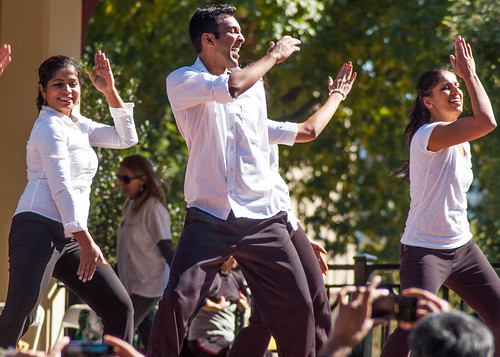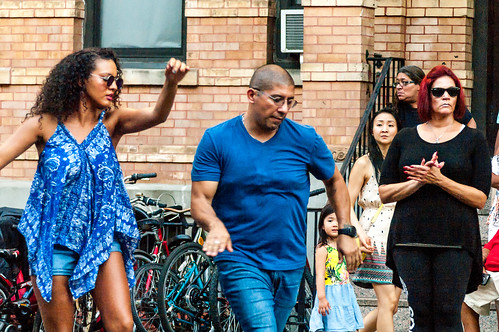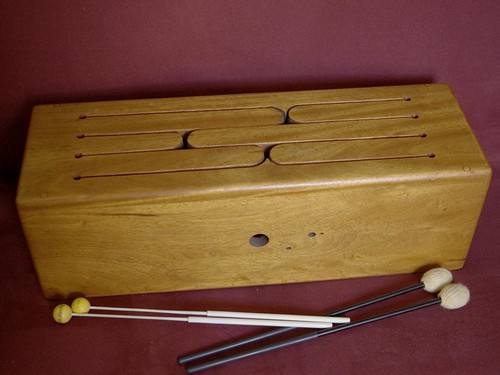On Wednesday 13 February 2002 I attended a workshop conducted by
William Parker. It was held in downtown Manhattan at 228 W. Broadway. The participants included two guitarists (electric), a vocalist, a trumpeter (me) and, of course, Parker himself, playing tuba for this occasion (he’s best known for his work on stand-up bass). Not your standard jazz ensemble.
Free jazz was the idiom. Of course “free jazz” is a big territory, but it doesn’t much matter just where in that territory we were located.
Parker made some general statements about this and that, and had variously wry, witty, and informative comments about the working methods of many of the folks he’s played with – Cecil Taylor, Ornette Coleman, Don Cherry, Muhal Abrams, and so forth. But mostly we made music. And it really was music that we made. And pretty good music at that. The kind of music where, when it’s over, you don’t want to talk. You just remain silent for a moment, collecting yourself, deploying your parachute so as to slow down your descent into lower Manhattan.
We started with something Parker called “Number 14” — which he concocted on the spot. As he said, it starts with four fours. “What’s that?” you ask. You play four notes at a rapid clip, and do that four times in a row. “What four notes?” you ask. “He didn’t tell us, and none of us asked.” We all picked the notes we wanted when it came time to play the piece. But there’s more to “Number 14” than four fours. After four fours there’s a pause, that’s so, just like that, long. After the pause everyone picks a high note and does a long descending gliss(ando) to some low note. “What high note to what low note?” you ask. “Do you really think there’s a specific answer to that question?” says I. And then we play a long trill. “On notes of your choice,” you remark. “Yes, that’s it.” After that, guitar one plays a simple one two figure and repeats it four times. Then the ensemble does another high to low gliss to trill. That’s the “head” to “Number 14.” After the head, it was up to us and the music to negotiate the flow.
So we went through the head a couple of times and then played it down. It must have gone for twenty or thirty minutes. It started out pretty raggedy, but then things started to settle in—though “settle “ is not a particularly good word to use here. There’s no easy way to describe the music that evolved. Sometimes there was a pulse, sometimes there wasn’t. Even when there was a pulse, there where times when some people didn’t follow it. Sometimes everyone was playing, sometimes only one or two were. Sometimes loud, sometimes soft, sometimes fast, sometimes slow, always shifting. Sometimes full-tilt bozo, sometimes approaching serene.
You need to understand that this is different from, say, your standard mainstream jazz quintet (there were five of us) in various ways. For one thing, the head wasn’t particularly definite; and there were no set chord changes or modes, no set back-up figures or ensemble passages. But, major though that may seem, those differences from the mainstream are, in fact, secondary. More profoundly, the traditional instrumental roles were gone. Traditionally there’s a rhythm section (piano and/or guitar, drums, and bass) and a front line (horns, vocal, guitar). The front line players do the head and then they play solos; meanwhile the rhythm section provides support (and gets a bit of solo action as well, depending on the format). Within the rhythm section, the drums, bass, and piano each has a role to play.
Well, in our music, all that disappeared. There’s no distinction between front line and rhythm section, and no fixed division of rhythm section responsibilities. It’s all up in the air, to be negotiated and reconfigured moment by moment. What this implies is that the old head-solos-head format disappears as well. There are no solos as such. This is collective improvisation, a conversation among equals, true democracy (to put a Ken Burns twist on the proceedings). Now, at this or that moment, one player might be more out front — either because she stepped out there or the others stepped back — but this is not dictated by any plan. It just happens. So we’ve got a floating mélange of quasi-solos, duos, trios and quartets all within the framework of the overall quintet.
How do you cope with a situation like that? I can’t answer the question in general, but I can say a little about how I approached it: With my ears. I’m always aware of what’s going on. Now sometimes I’m focused on what I’m doing and not so much on anyone or everything else. But I’m aware of it nonetheless. And when I’m focused on my own playing I might be doing complex stuff, or I might be repeating a simple three-note riff, or even a long tone. But I also make it a practice to spend some time explicitly focusing on what each other player is doing and to orient myself to those sounds in some way. Perhaps I’ll imitate them, or play an answer to them, or support them, or create a counter line. There are lots of ways to orient yourself to what other people are doing and it’s very important that you do so with each player, one at a time. It’s part of your responsibility as a citizen in this improvisatory democracy.
To return to traditional ways of thinking, what this means for me is that some of the time I’m thinking and playing like a soloist — my instrument’s traditional role in mainstream jazz — but that I spend more time thinking and playing like a bass player (though the trumpet is a soprano instrument, but that’s no reason I can’t provide an anchoring ostinato) or pianist (playing arpeggios) or even like a drummer (playing staccato hits). And when the vocalist would sing long tones, I might support her by playing long tones (more or less) with her.
It’s like going into a theatrical costume shop and trying on all the different costumes. Everyone else is doing the same thing. You meet in various configurations and improvise a little skit that’s consistent with your costumes. Then you change costumes and do it again, and again.
Until it’s over. And that’s the interesting thing. How do you know it’s over? Since there’s no set plan, no check list of things to accomplish (as in the head-solos-head format), you need some other way to end it. You might think that, since William Parker was leading this workshop, that he ‘d end it. But he didn’t. We all ended it, and at the same time.
That was the first time through “Number 14.” We did it a second time. Then we worked on some conceptions from other workshoppers. And then it was over. We didn’t have time for “Number 15.”


















